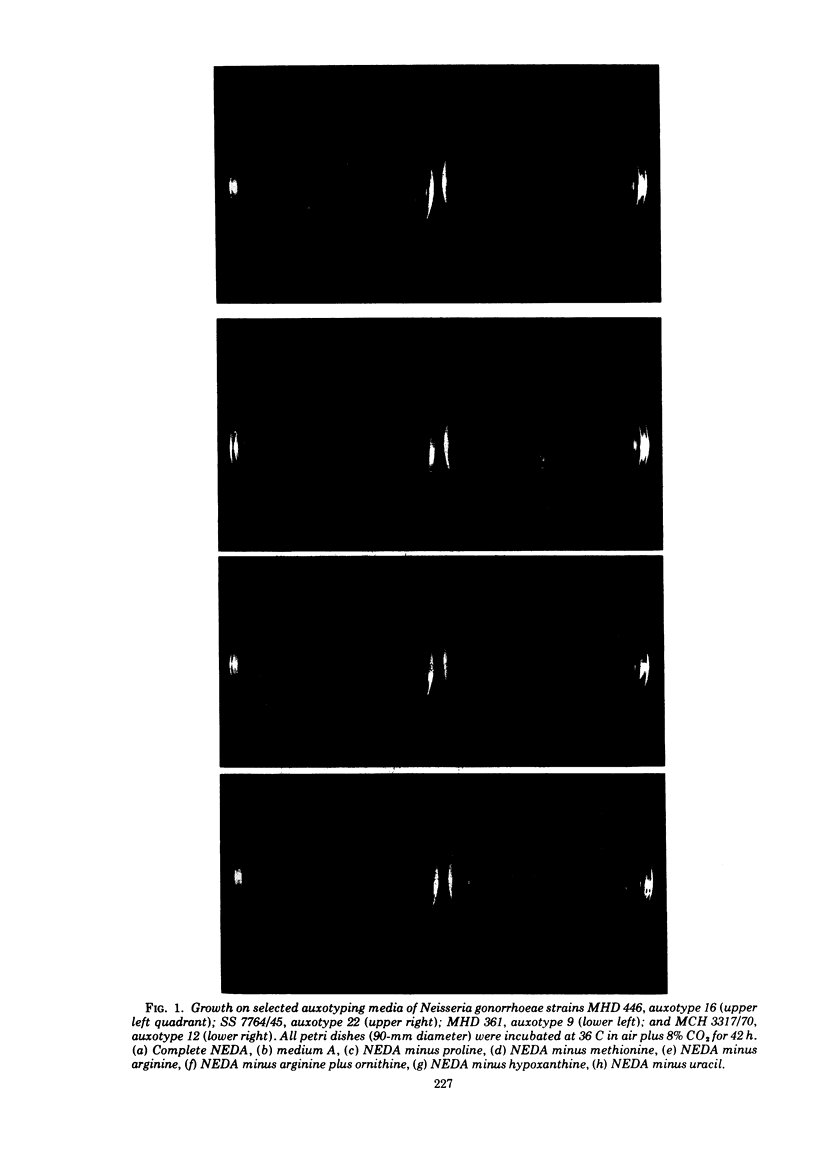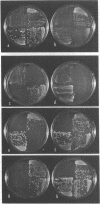Abstract
A system is described for differentiating clinïcal isolates of Neisseria gonorrhoeae based on their growth or absence of growth on a set of 11 chemically defined agar media. The complete medium, NEDA, contains all of the compounds required for gonococcal growth; but isolates differ in their ability to grow on NEDA from which selected compounds are individually omitted. The differential compounds include L-proline, L-arginine, L-ornithine, L-methionine, hypoxanthine, uracil, thiamine, and thiamine pyrophosphate. A distinctive pattern of growth responses on the standard media defines an auxotype. Twenty auxotypes were found among a group of 251 gonococci which were isolated from patients examined in the clinics of one city during a 3-month span of time. Another collection of 74 strains from several different countries yielded two additional auxotypes. The stability of the nutritional requirements on which the auxotyping depends was verified in two ways. Cultures isolated from different anatomic sites of a patient or from sexual partners represented the same auxotype, as did cultures which were repeatedly isolated from cases of presumptive treatment failures. Also, the auxotypes of gonococci remained the same after numerous subcultures. The reproducibility of results and the variety and number of auxotypes indicate the potential value of the auxotyping system as an epidemiological tool.
Full text
PDF







Images in this article
Selected References
These references are in PubMed. This may not be the complete list of references from this article.
- Hunter K. M., McVeigh I. Development of a chemically defined medium for growth of Neisseria gonorrhoeae. Antonie Van Leeuwenhoek. 1970;36(2):305–316. doi: 10.1007/BF02069032. [DOI] [PubMed] [Google Scholar]
- Jephcott A. E., Reyn A., Birch-Andersen A. Neisseria gonorrhoeae 3. Demonstration of presumed appendages to cells from different colony types. Acta Pathol Microbiol Scand B Microbiol Immunol. 1971;79(3):437–439. doi: 10.1111/j.1699-0463.1971.tb00086.x. [DOI] [PubMed] [Google Scholar]
- Jephcott A. E., Reyn A. Neisseria gonorrhoeae. Colony variation I. Acta Pathol Microbiol Scand B Microbiol Immunol. 1971;79(5):609–614. doi: 10.1111/j.1699-0463.1971.tb00088.x. [DOI] [PubMed] [Google Scholar]
- KELLOGG D. S., Jr, PEACOCK W. L., Jr, DEACON W. E., BROWN L., PIRKLE D. I. NEISSERIA GONORRHOEAE. I. VIRULENCE GENETICALLY LINKED TO CLONAL VARIATION. J Bacteriol. 1963 Jun;85:1274–1279. doi: 10.1128/jb.85.6.1274-1279.1963. [DOI] [PMC free article] [PubMed] [Google Scholar]
- Kellogg D. S., Jr, Cohen I. R., Norins L. C., Schroeter A. L., Reising G. Neisseria gonorrhoeae. II. Colonial variation and pathogenicity during 35 months in vitro. J Bacteriol. 1968 Sep;96(3):596–605. doi: 10.1128/jb.96.3.596-605.1968. [DOI] [PMC free article] [PubMed] [Google Scholar]
- Martin J. E., Jr, Billings T. E., Hackney J. F., Thayer J. D. Primary isolation of N. gonorrhoeae with a new commercial medium. Public Health Rep. 1967 Apr;82(4):361–363. [PMC free article] [PubMed] [Google Scholar]
- Reyn A., Schmidt H., Trier M., Bentzon M. W. Spectinomycin hydrochloride (Trobicin) in the treatment of gonorrhoea. Observation of resistant strains of Neisseria gonorrhoeae. Br J Vener Dis. 1973 Feb;49(1):54–59. doi: 10.1136/sti.49.1.54. [DOI] [PMC free article] [PubMed] [Google Scholar]
- WHITE L. A., KELLOGG D. S., Jr NEISSERIA GONORRHOEAE IDENTIFICATION IN DIRECT SMEARS BY A FLUORESCENT ANTIBODY-COUNTERSTAIN METHOD. Appl Microbiol. 1965 Mar;13:171–174. doi: 10.1128/am.13.2.171-174.1965. [DOI] [PMC free article] [PubMed] [Google Scholar]



